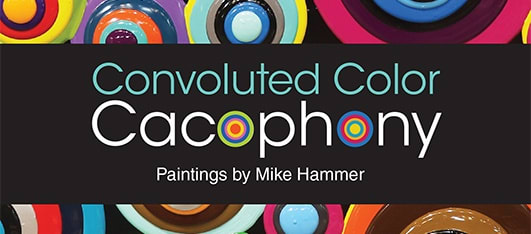Convoluted Color Cacophony is an exhibition of a dozen “blob” paintings by international artist Mike Hammer at Rosenbaum Contemporary gallery, 150 Yamato Road in Boca Raton, Florida, during the months of March through May 2020. A survey of process paintings, Convoluted Color Cacophony walks the line of art historical lineages and good-humored nonsensicalness.
The very notion of “process painting” is a relatively newer concept in the overall chronology of art history– especially in relation to post -war contemporary, non-representational art—an artistic model where the production and means to the creation of artwork is as important, or sometimes more imperative, than the final executed product. Often discussed in academic circles for the second and third generation abstract expressionists, the process painting methods dealt initially with artistic delivery—splatters, drips, automaticisms, and conceptual executions.
Abstract expressionist painter Jackson Pollock discussed his paintings existing in space and time, floating in the air, almost alive before they hit the canvas—slamming onto the canvas and shattering the visual levitation and three-dimensional exceptionality.
Mike Hammer, an artist known for his “blob” paintings, is a self-proclaimed process painter from Canada. His artwork is a textbook case for the notion that artists who are working in a variety of media, techniques, processes and intentions, can arrive at a similar visual aesthetic. However, the individual’s personal experiences, preferences, and preferred habits of creation guide the process.
Hammer, evoking inspiration from contemporary artist Holton Rower, seems to purposefully educate himself on the swaths of contemporary artists who are producing blob paintings in an effort to pride himself on his own individualized production methods. One early pioneer of this pouring-based blob genre, Italian artist Davide Nido, glued down and stacked his pre-hardened and poured paint circles, while Hammer pours directly on the wood panels, allowing layers of acrylic to cure before adding additional layers. He builds layer upon layer, a visual fine art stalactite. This sculptural sensibility becomes more evocative and propels the paintings into sculptural elements on the wall which intrude on the viewers' space, budging into their personal proximity, but in a playful and whimsical meddle.
It’s Smashing, Darling! is a 72- x 84-inch painting that demands attention. With over 6,000 square inches of blobs, Hammer accentuates each and every circle of paint with its own white halo. In viewing It’s Smashing, Darling!, I am reminded of a passage written by former chief curator of painting and sculpture at the Museum of Modern Art, New York, John Elderfeld. In the Morris Louis: The Museum of Modern Art New York exhibition catalog, printed in 1986, Elderfeld states:
“…Midway through the century, that 'great labor' insofar as painting was concerned, came to involve reimagining what constitutes the art of painting—not simply producing new paintings, but new paintings whose very method of creation reformulated what the very act of making a painting comprised.” (1)
Elderfeld was of course was describing Morris Louis’ pouring technique for his stain paintings of the 1950s. But these sentiments can also be applied 70-plus years later to the innovative ways in which Mike Hammer creates his artworks: a type of pouring from customized squeeze-bottles onto flat panels. The notion of working flat also harkens back to Jackson Pollock’s mentality where the artist was “breaking open painting by experimenting with the materials of painting itself…having chosen to work on the floor, it made the canvas more material, more a real surface and not an ideal picture plane.” (2)
Hammer’s process painting even propels Clement Greenberg’s ideas in his signature essay, “The Crisis of the Easel Picture,” expanding on contents pertaining to “flatness and frontality.” (3)
Hammer is neither flat nor frontal but dimensional, breaking through a two-dimensional painting appearance while understandably eliminating and dismissing the crux of easel painting techniques.
As far as the bold and bright color palette, Hammer declares: “…blobs are composed of various color schemes, from analogous or complementary colors to shades of a single hue to alternating colors that create a Dr. Seuss effect. Staying true to my spirit of experimentation, I often include garish or obviously mismatched colors.”
While each blob in each painting is essentially a visual element on its own, the collective “civil society” of these blobs portrays a “third sector” or visual perception of compositional awareness distinct from the usual compositional features of traditional art, an independent aesthetic that ventures beyond foreground and background.
This new visual experience is the juddering of circular entities, atoms pulsating together and generating a kind of molecular vibration—a harmonic motion.
Pressure Zone, a 20- x 20-inch-square painting, evokes dispositions of Kenneth Noland color field circle paintings and Jasper Johns’ targets. Varying size blobs and circles create three-dimensional mischievous ogles and playful foci that distract us and hypnotize our thoughts and ambitions. With a stark, black background, the blobs float in an ambiguous cosmic space.
Mike Hammer’s blob paintings are sophisticated, like the aboriginal dot symbology paintings, but non-educational with an infusion of kindergarten googly-eye playfulness.
(1) Elderfeld, John. Morris Louis: The Museum of Modern Art. New York. p. 25.
(2) Elderfeld, John. Morris Louis: The Museum of Modern Art. New York. p. 14.
(3) Greenberg, Clement. “The Crisis of the Easel Picture,” Art and Culture. Beacon Press. 1989.


